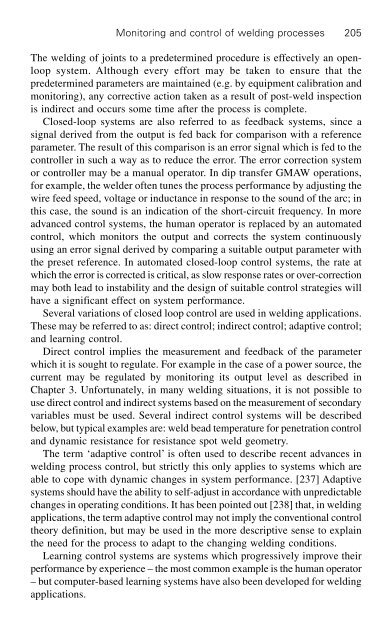Advanced Welding Processes: Technologies and Process Control
Advanced Welding Processes: Technologies and Process Control
Advanced Welding Processes: Technologies and Process Control
Create successful ePaper yourself
Turn your PDF publications into a flip-book with our unique Google optimized e-Paper software.
Monitoring <strong>and</strong> control of welding processes 205<br />
The welding of joints to a predetermined procedure is effectively an openloop<br />
system. Although every effort may be taken to ensure that the<br />
predetermined parameters are maintained (e.g. by equipment calibration <strong>and</strong><br />
monitoring), any corrective action taken as a result of post-weld inspection<br />
is indirect <strong>and</strong> occurs some time after the process is complete.<br />
Closed-loop systems are also referred to as feedback systems, since a<br />
signal derived from the output is fed back for comparison with a reference<br />
parameter. The result of this comparison is an error signal which is fed to the<br />
controller in such a way as to reduce the error. The error correction system<br />
or controller may be a manual operator. In dip transfer GMAW operations,<br />
for example, the welder often tunes the process performance by adjusting the<br />
wire feed speed, voltage or inductance in response to the sound of the arc; in<br />
this case, the sound is an indication of the short-circuit frequency. In more<br />
advanced control systems, the human operator is replaced by an automated<br />
control, which monitors the output <strong>and</strong> corrects the system continuously<br />
using an error signal derived by comparing a suitable output parameter with<br />
the preset reference. In automated closed-loop control systems, the rate at<br />
which the error is corrected is critical, as slow response rates or over-correction<br />
may both lead to instability <strong>and</strong> the design of suitable control strategies will<br />
have a significant effect on system performance.<br />
Several variations of closed loop control are used in welding applications.<br />
These may be referred to as: direct control; indirect control; adaptive control;<br />
<strong>and</strong> learning control.<br />
Direct control implies the measurement <strong>and</strong> feedback of the parameter<br />
which it is sought to regulate. For example in the case of a power source, the<br />
current may be regulated by monitoring its output level as described in<br />
Chapter 3. Unfortunately, in many welding situations, it is not possible to<br />
use direct control <strong>and</strong> indirect systems based on the measurement of secondary<br />
variables must be used. Several indirect control systems will be described<br />
below, but typical examples are: weld bead temperature for penetration control<br />
<strong>and</strong> dynamic resistance for resistance spot weld geometry.<br />
The term ‘adaptive control’ is often used to describe recent advances in<br />
welding process control, but strictly this only applies to systems which are<br />
able to cope with dynamic changes in system performance. [237] Adaptive<br />
systems should have the ability to self-adjust in accordance with unpredictable<br />
changes in operating conditions. It has been pointed out [238] that, in welding<br />
applications, the term adaptive control may not imply the conventional control<br />
theory definition, but may be used in the more descriptive sense to explain<br />
the need for the process to adapt to the changing welding conditions.<br />
Learning control systems are systems which progressively improve their<br />
performance by experience – the most common example is the human operator<br />
– but computer-based learning systems have also been developed for welding<br />
applications.


